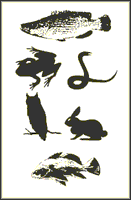Nebraska Cooperative Fish and Wildlife Research Unit

Nebraska Cooperative Fish and Wildlife Research Unit: Staff Publications
Date of this Version
1994
Abstract
To test potential competitive interactions between larvae of white crappie Pomoxis annularis and of gizzard shad Dorosoma cepedianum. we added adult gizzard shad to eight of twelve 0.1-ha ponds that had been stocked with adult white crappies. Larval white crappies and larval gizzard shad appeared within 1 week of one another and larval white crappie density did not differ between treatments. Zooplankton density declined similarly between treatments, and zooplankton species composition and size did not differ. Although larval white crappie and larval gizzard shad had moderate diet overlap, prey selection by white crappie did not differ between treatments. During April, more than 70% of larval gizzard shad had empty stomachs, compared with less than 20% of larval white crappies. Age-0 gizzard shad recovery was extremely low (< 10 kg/ha) in five of eight ponds. Daily ring counts from otoliths indicated that late-spawned gizzard shad had higher growth rates than early-spawned gizzard shad, whereas no such relationship existed for white crappie. At a given size, age-0 white crappies weighed more in ponds with gizzard shad than in ponds without them. Contrary to our predictions, gizzard shad did not negatively affect age-0 white crappies.


Comments
Published in Transactions of the American Fisheries Society 123:975-987. 1994